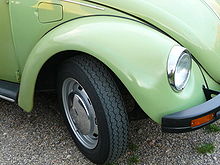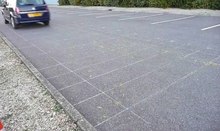fender

The term fenders are used to refer to the body parts of vehicles - usually in motor vehicles - that are attached over the wheels .
The mudguard is used to cover the wheels of a vehicle sufficiently so that no other road users , especially pedestrians, are endangered by the rotational movement of a free-standing wheel. According to German motor vehicle law (§ 36a StVZO ), wheels must not protrude from the body or must have a cover for this reason. There are similar regulations in other countries. Fenders also prevent unnecessarily large swirling of water from the road surface, which could obstruct the view of road users behind. This would occur in extreme form with free-standing wheels.
The term fender itself originated at a time when carriages still dominated the streets. The then mostly open and horse- drawn wagons were fitted with covers over the wheels, which, due to their curved shape, were reminiscent of bird's wings . Kot originally meant "dirt, dirt" - as it is today in Austria - but also stood for horse manure and human feces , which at that time were often disposed of on the open road. The purpose of these covers was that the wheels of the carriages could not throw the street manure directly onto the vehicle or even into the interior of the carriage and so dirty the occupants. The mudguard fulfills the same function on a bicycle .
Cover over the wheels of a carriage (with Kaiser Wilhelm II. )
Fender on a Ford Model T 1924
Fender on a 1938 Chrysler , marked red
Left front fender on a VW Golf I.
literature
- Hans-Hermann Braess, Ulrich Seiffert: Vieweg manual automotive technology. 2nd edition, Friedrich Vieweg & Sohn Verlagsgesellschaft mbH, Braunschweig / Wiesbaden 2001, ISBN 3-528-13114-4






